Paying tribute to a Marvel great…
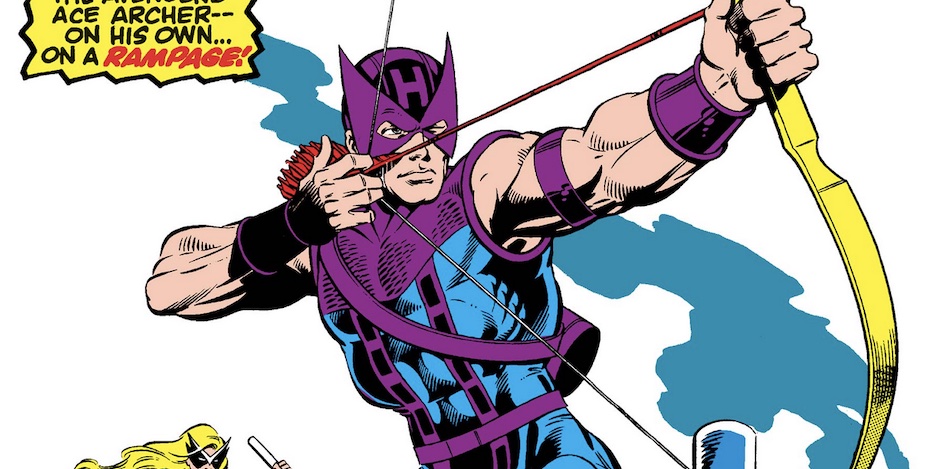
By CHRIS RYALL and SCOTT TIPTON
Both of us are avid fans of 1970s and 1980s Marvel, and the creatives who made that work happen. In particular, I think we both have a soft spot for the quintessential Marvel editor, the much-missed Marvelous Mark Gruenwald. On this occasion — he was born 70 years ago on June 18, 1953 — join us as we look back at 13 great stories (and covers) spanning the career of the legendary Gru!
—
Hawkeye #1 (1983). Scott Tipton: This is a big one for me personally. Gruenwald both wrote and pencilled this miniseries, one of Marvel’s first, and while Gruenwald benefits from great inks throughout the series, there’s no denying that his layouts and storytelling are spot-on. This series cemented everything I loved about the Clint Barton character, and remains my template for how I think about him: brave, vulnerable, stubborn and, above all else, determined.
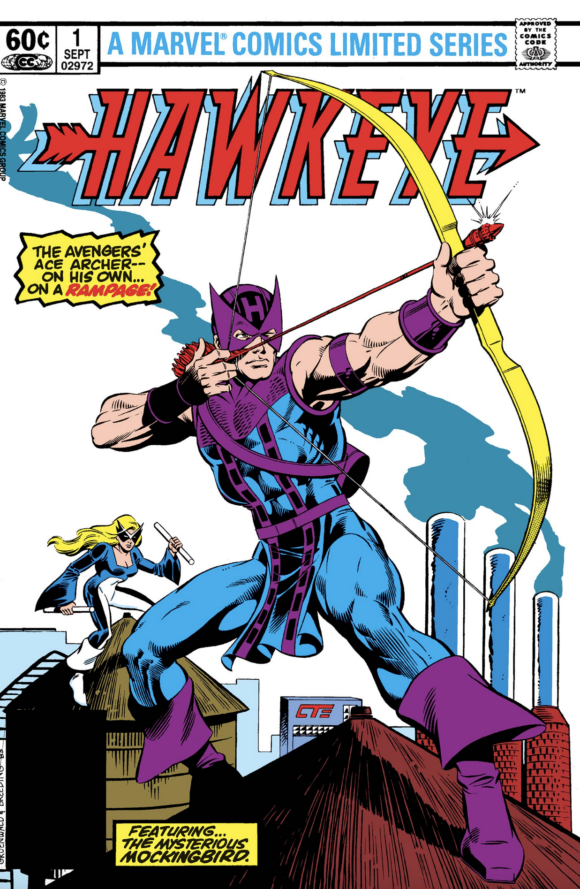
Gruenwald pencils, Brett Breeding inks
Gruenwald’s decision to marry off Hawkeye to Mockingbird (in a clear tip of the hat to the Distinguished Competition’s Green Arrow and Black Canary) opened up the character in so many ways, and gave Marvel’s most unlucky-in-love hero a long-needed happy ending… at least for a while.
—
Squadron Supreme #1 (1985). Chris Ryall: This series rightfully gets talked up as a kind of “Watchmen before Watchmen” exploration of what happens when superheroes set out to fix all the world’s problems, and just how awry that savior mindset can go. But it still always felt like it didn’t get its proper due, which may be in part because this series had three or four artists over the course of its 12 issues and Watchmen had one superstar artist, Dave Gibbons. All the artists acquit themselves well here but it’s Gruenwald who shines, taking characters that began as Marvel’s answer/homage to the Justice League and making them more distinctive than they’d ever been.
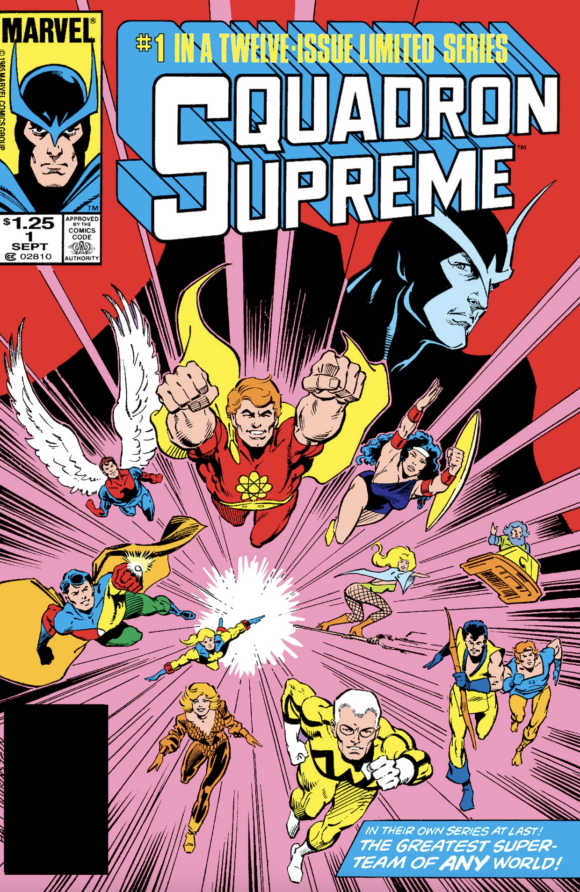
Bob Hall pencils, Joe Rubinstein inks
There have been lots of “superheroes-turned-absolute-rulers” stories in the post-Watchmen years but it’s because of writer Mark Gruenwald that this one rises above the ones that followed. The series avoids the usual nihilistic tone of similar tales because Gruenwald came at the story from a place of real love of superheroes. His work here made the readers care for, or at least understand, these very flawed characters in ways that make this series stand apart. The series has been collected in trade paperback and is well worth your time.
—
Captain America #332 (1987). Tipton: Another landmark Gru-written issue, Captain America #332 kicks off the “President Fires Cap” storyline, in which Steve Rogers relinquishes his role as Captain America rather than being forced to take orders directly from the federal government, and we see in the government’s misguided and ultimately failed effort to replace him that there’s so much more to being Captain America than just finding someone else to wear the suit. In Gruenwald’s legendary decade-long run on the character, this story arc is definitely the highlight.
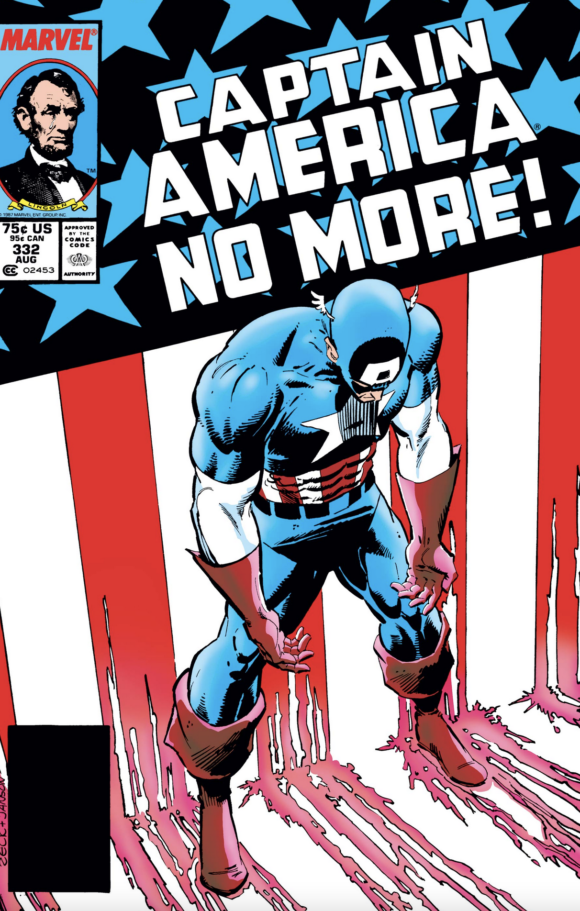
Mike Zeck pencils, Klaus Janson inks
—
What If? #32 (1982). Ryall: Much like with Squadron Supreme, this one-shot story explores the ramifications of when a team’s best intentions to bring — force — order onto a world explode in their faces. Most of Marvel’s What If? stories ended on a dour note — who wants to read an alternate take where things worked out better for our heroes — and this one certainly follows suit (especially when a naked Korvac takes a seat on Earth like it’s an exercise ball before using Galactus’ Ultimate Nullifier to ultimate effects).
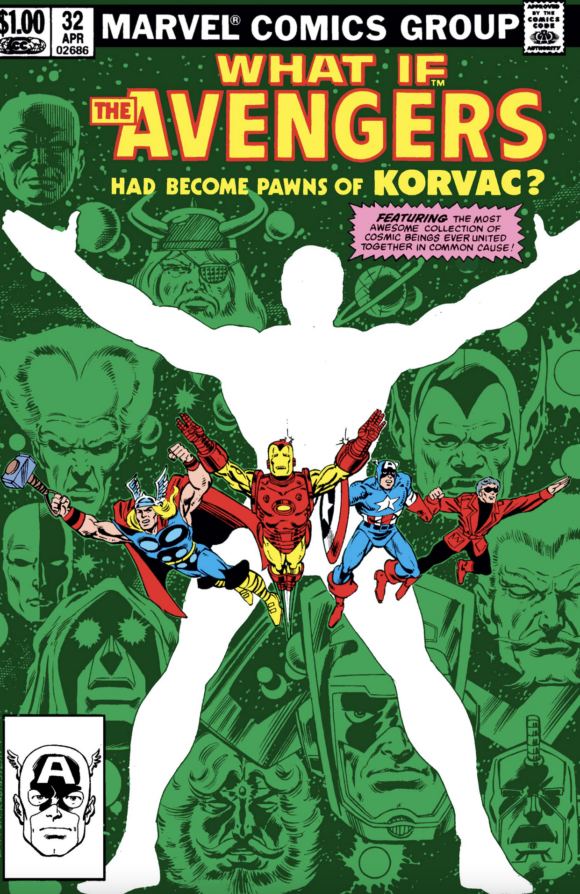
Bob Layton pencils, Rubinstein inks
Not only is Gru’s story epic but art-wise, this issue is something special, too. Gruenwald and Greg Laroque share penciling duties on it but a Murderer’s Row of 1980s Marvel talent inks the individual characters: John Byrne, Frank Miller, Bob Layton, and many others each tackle a single character throughout the book. Which had to be a scheduling nightmare, and it sounds like it’d make for a stylistic mess but it all works. So much so that this issue got a rare What If? sequel story in Issue #41 (albeit with inferior inks over Gru’s pencils in that one).
—
Marvel Super Hero Contest of Champions #1 (1982). Tipton: Among Marvel’s early miniseries was another innovation of Mark’s, Contest of Champions, originally planned as a tie-in to the 1980 Olympics until the United States’ withdrawal from the Games made the whole project moot. When it was discovered that inker Pablo Marcos hadn’t been told that the project was cancelled and had inked over 40 pages, it was Mark who took the project under his wing and transformed it into the first companywide crossover in Marvel history.
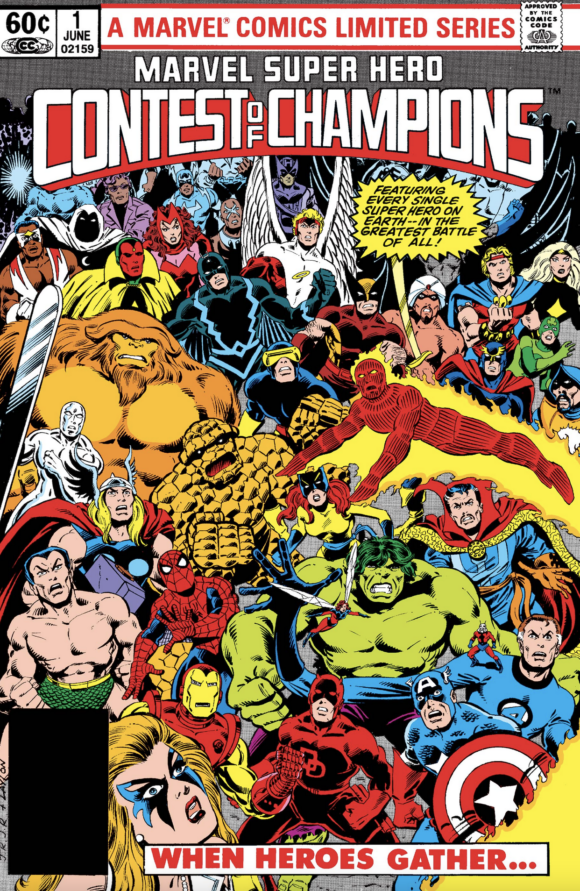
John Romita Jr. pencils, Layton inks
—
Marvel Two-in-One #60 (1980). Ryall: I know in theory that the excellent “Project Pegasus” storyline that ran just prior to this issue is probably the single best Marvel Two-in-One arc in the title’s existence, and since those issues, like this one, were co-written by Mark Gruenwald and Ralph Macchio, and feature great art by George Perez and John Byrne, it makes no good sense to not pick one of those covers to represent Gru’s solid Two-in-One work.
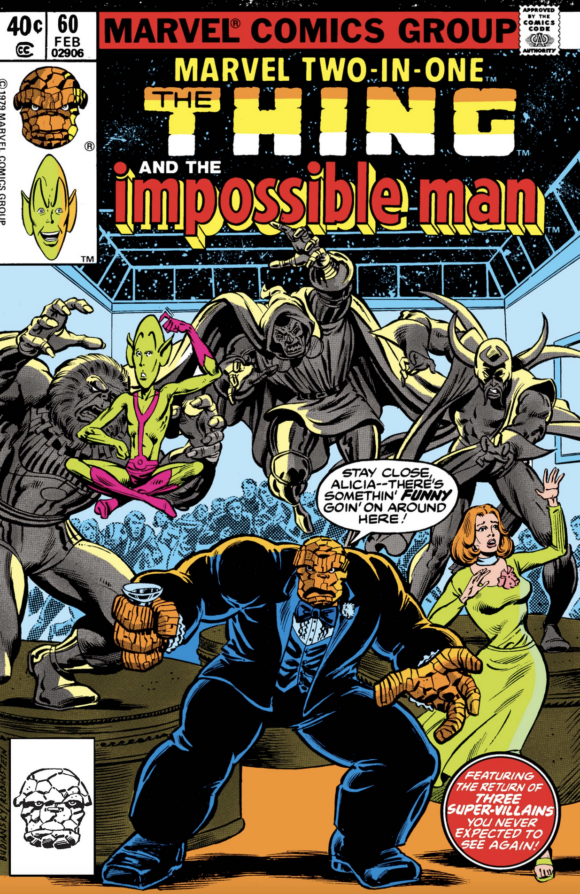
Bob Budiansky pencils, Rubinstein inks
But the heart wants what it wants, and what mine wanted was to see the Thing and the often (usually… OK, always) ridiculous Impossible Man interacting in a low-stakes adventure like this one. Impy has at times been Marvel’s most annoying character (pre-Deadpool, anyway. Or at least pre-Gru’s Madcap). But in the right hands, he can provide some solid amusement. And this issue abounds with the right hands, from the aforementioned co-writers, who could bring the humor as well as the adventure, along with the expert art team of George Perez and gone-too-soon Gene Day. It’s a trifle of the very best kind, the sort of thing only a continuity-loving writer like Gruenwald could deliver with any consistency.
—
The Official Handbook of the Marvel Universe #15 (1984). Tipton: OHOTMU was another Gruenwald innovation, a primarily prose encyclopedia of all OF Marvel’s characters, concepts, locations and artifacts, treated as respectfully and seriously as any real-world reference book — which I think was the secret to its success. The people creating it believed it, so you did too. This was the first issue of the series I ever saw, which focused on all the Marvel Universe’s weaponry and technology, as illustrated by Marvel’s in-house faux engineer Eliot R. Brown. After this, I was hooked.
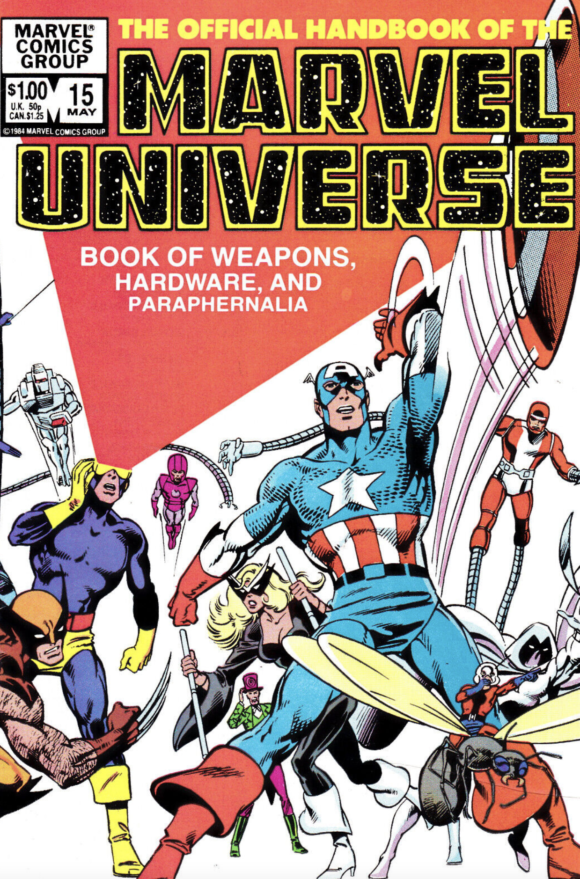
John Byrne pencils, Rubinstein inks
—
D.P. 7. #1 (1986). Ryall: It feels fitting to discuss a New Universe entry here because the covers for the various series in Marvel’s big mid-’80s initiative were often the only good parts of this “world outside your window.” The New Universe was maybe the most inconsistent, frustrating, and botched launches in comic-book history. But it did have its moments, most of which could be found on the pages of Mark Gruenwald and Paul Ryan’s D.P. 7.
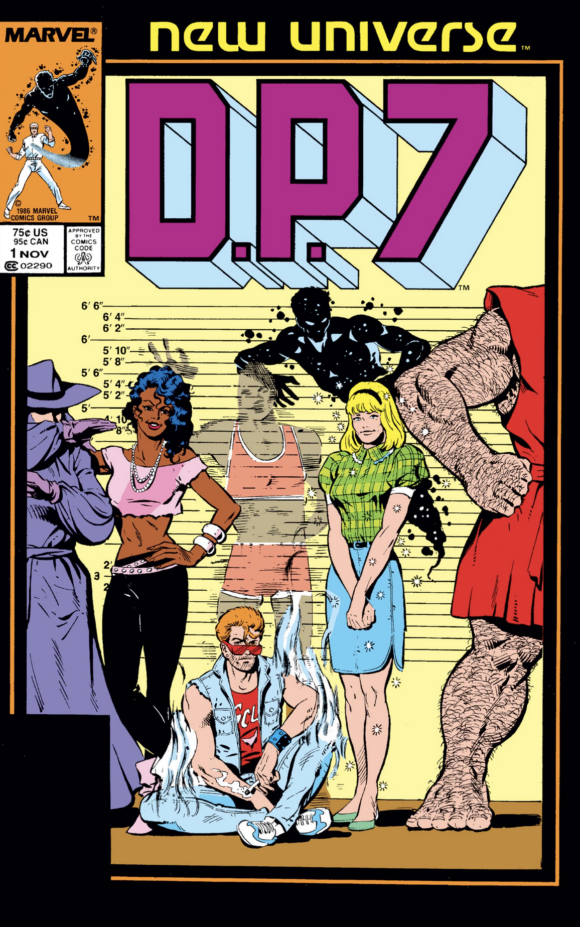
Paul Ryan
The series stuck with the New U’s original concept of “regular folk in the real world getting superpowers” longer than most of the other series, and certainly more effectively than the others, too. The series had a great first year before it was derailed by the oh-so-misguided Pitt that signaled the beginning of the end for all these titles. But the characters Gru and Ryan developed here deserved more then, and would be great additions to the Marvel Universe proper now.
—
Quasar #17 (1990). Tipton. I always feel like Quasar is the one long-term work of Mark’s that gets consistently overlooked, and it’s a shame, as it’s where he explored some of his trippier concepts, thanks to the hero’s more cosmic nature. Here in Issue #17, he takes the classic DC notion of the Superman/Flash race and applies it to the Marvel Universe, with the winner being both a complete surprise and exactly the person it should be.
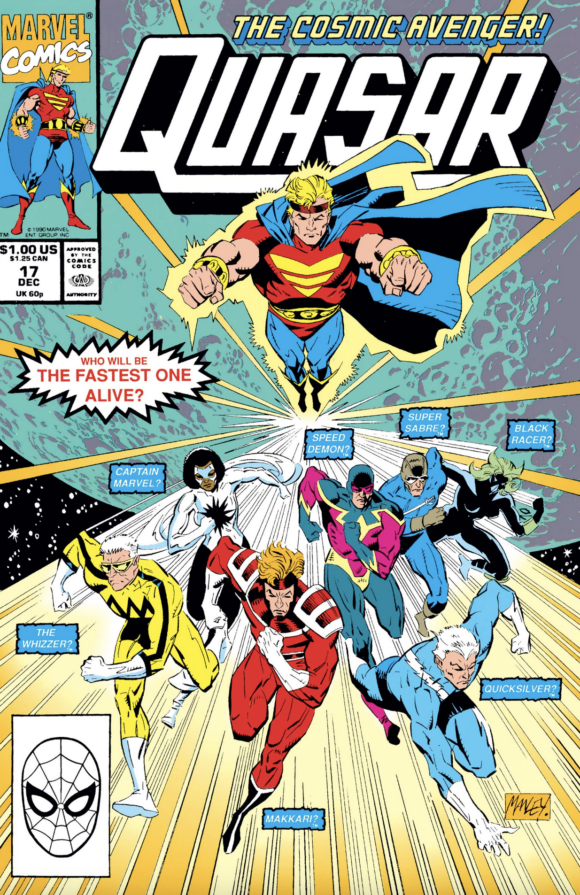
Mike Manley
—
Captain America #319 (1986). Ryall: Throughout various Marvel titles but primarily in the pages of Gru’s Captain America, an unknown assassin was going around killing secondary (or, really, tertiary-at-best) villains. As much as we never knew anything about the inner lives of, say, the Ringer or the Basilisk, it was still jarring to see all of these characters get their chests blown out by the mysterious Scourge. Deaths were usually signaled by the “PUM!” sound of the gun being fired and the “SPAK!” sound of the explosive exit. Gripping stuff for Code-approved superhero comics.
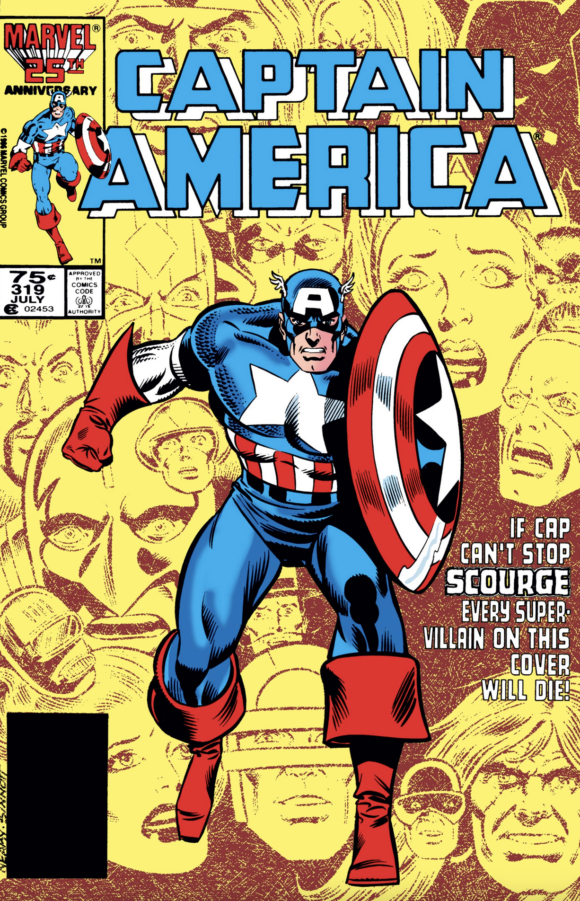
Paul Neary pencils, Joe Sinnott inks
This cover in particular accomplished a couple things that work for me: I love floating heads and outside of a George Perez Crisis cover, it may have the most floaters than on any other comic. Also, it’s got the title character in vivid color in the foreground against a more monochromatic background, another favorite approach of mine. Just based on the contents of this issue, if anyone invites you to grab happy hour drinks at The Bar With No Name, maybe tell them you’re busy that day…
—
Hawkeye #4 (1983). Tipton: I had to go back to the Hawkeye miniseries one more time, not only because it’s one of Gruenwald’s very few cover penciling jobs, but also because it’s just so grim! (Even if it is a bit of a cheat, as this scene only happened in a kind of “what if” imaginary moment as the series villain Crossfire explains his master plan.) It also always struck me that it was nice of Thor to be so respectful as to take off his helmet.
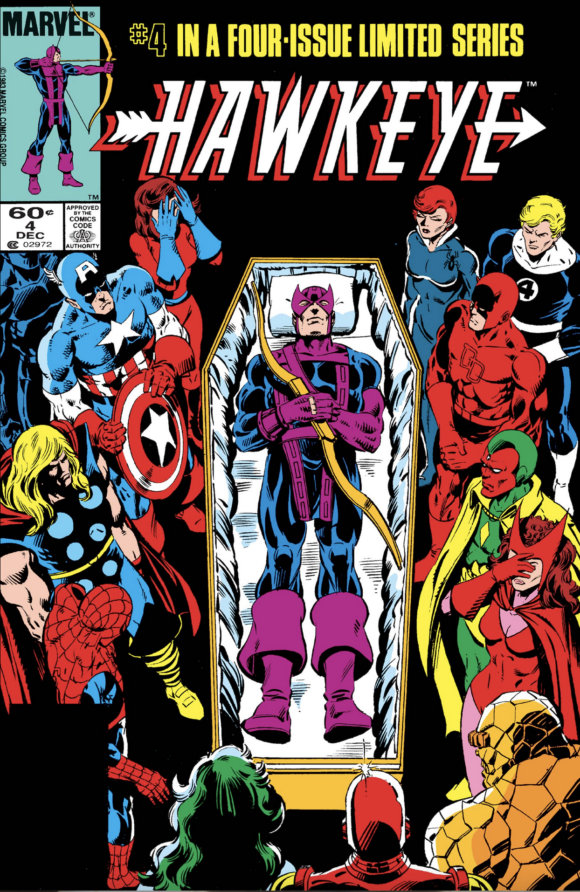
Gruenwald pencils. Layton inks
—
Solo Avengers #1 (1987). Tipton: Mark was the editor on this series, and its inclusion here (aside from the strong artwork by Mark Bright) is for entirely personal and sentimental reasons. This was the series where I got to know Mark personally, after his hilarious long-distance phone call to my house to razz me about something I’d written to the book’s letter column. In the years that followed, through correspondence and conventions, we became friends, and even planned to work together in the future, before his tragic and far-too-early death in 1996.
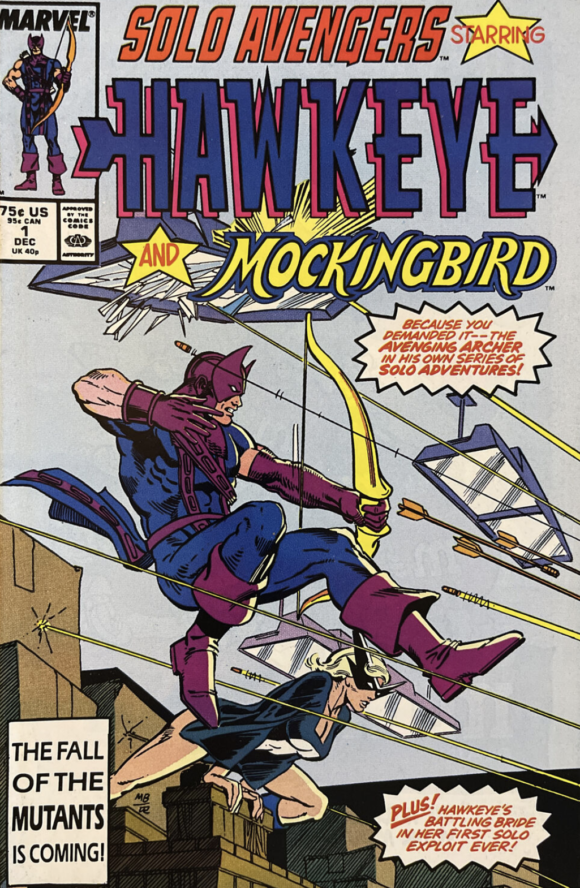
Mark Bright pencils, Rubinstein inks
Solo Avengers is all but forgotten these days, with no Epic Collection or Masterworks treatment in the offing, but trust me, it was a great little series. Try to track it down at your next convention.
—
The Official Handbook of the Marvel Universe: Deluxe Edition #1 (1985). Ryall: Any Marvel Handbook cover would’ve sufficed here, since every issue was a wonder of character details, Marvel history, and assorted other revelations, courtesy of lead writer/historian Mark Gruenwald. This particular cover is the first issue of the second, Deluxe Edition series. The first run had great covers by Ed Hannigan and John Byrne but even better were these deluxe Byrne covers, each of which connected to the following issue. The variety of poses and approaches Byrne took to basically every character in the Marvel Universe, despite the fact that they were all either flying or running in the same direction, made each one a standout. Also deserving of plenty of applause for this series is inker Joe Rubenstein, who inked the covers and the majority of the characters contained within each issue.
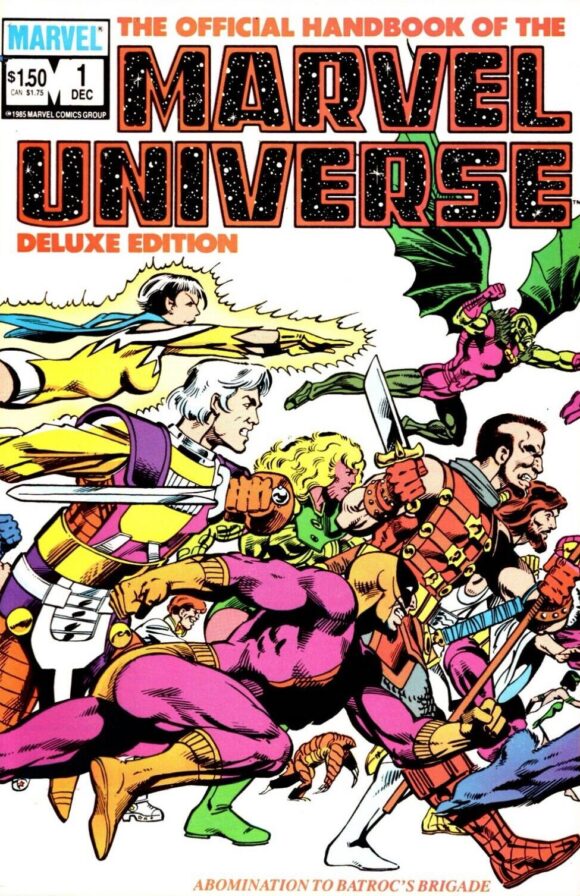
Byrne and Rubinstein
But the superstar here is Gruenwald, who, with his team, helped explain, define, and expand Marvel’s universe of characters. Even decades later, many of the details Gruenwald admittedly made up on the fly are still accepted as canon. This series alone was legend-making but considering that it’s just a small part of his much larger legacy is one more reason that Da Gru deserves every celebration thrown in his honor.
—
MORE
— SQUADRON SUPREME: An INSIDE LOOK at MARK GRUENWALD’s Magnum Opus. Click here.
— MARK GRUENWALD, His Ashes and Me, by Cat Schuller Gruenwald. Click here.
—
Scott Tipton is a 13th Dimension contributor-at-large and comics writer, best known for his work on IDW’s Star Trek series.
Chris Ryall is the co-owner/publisher of Image Comics imprint Syzygy Publishing. His latest series is Tales of Syzpense, launching June 21.

June 18, 2023
This is fantastic. I was 11 or 12 when I started reading Mr. Gruenwald’s work in the 80s, which was also around the time that I first became aware of the role of the writer in comics. Like most fans, I noticed the art first, but Mr. Gruenwald was the first comic writer that I could hear speaking to his readers through the story. Most of the time he was saying, “Hey, guys, look at what cool stuff you can do with these characters and the world they inhabit!”
June 20, 2023
Great spotlight on Mark Gruenwald. I read and enjoyed all of these books as they were published. Squadron Supreme, the Handbooks, and that What If? issue being highlights for me.
Solo Avengers is getting collected. The first Epic Collection is being solicited this month – Hawkeye Epic Collection: Way of the Arrow. Collects: Solo Avengers 1-20 and Avengers Spotlight 1. From the solicitation text, it sounds like the whole issues will be included, not just the Hawkeye half.
June 21, 2023
There is an awesome book about Gruenwald’s run in Captain America called Mark Gruenwald and the star-spangled symbolism of Captain America. Well worth the read if you are a fan of Gru.